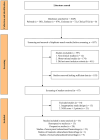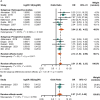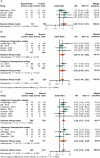Prognostic value of elevated cardiac troponin in aneurysmal subarachnoid hemorrhage: a systematic review and meta-analysis
- PMID: 40170897
- PMCID: PMC11960501
- DOI: 10.3389/fneur.2025.1506819
Prognostic value of elevated cardiac troponin in aneurysmal subarachnoid hemorrhage: a systematic review and meta-analysis
Abstract
Objective: Subarachnoid hemorrhage (SAH) is a common intracranial hemorrhagic condition associated with a high mortality rate and significant disability due to serious complications. In clinical practice, we have observed that elevated serum cardiac troponin (cTn) levels correlate with a poor prognosis in SAH. Although some studies have reported this correlation, these studies had small sample sizes and did not make a distinction between traumatic SAH and aneurysmal SAH. Accordingly, we aimed to systematically analyze the prognostic evaluation value of elevated cTn levels in SAH by reviewing all existing studies to provide a clinical reference.
Methods: We selected studies on cTn and SAH from PubMed, Medline, Embase, Web of Science, Cochrane Library, and Clinical Trails databases published before December 2023. The Newcastle-Ottawa Scale was used to evaluate the quality of the included studies. PRISMA and AMSTAR guidelines were followed to assess the methodological quality of the systematic review. We divided the included studies into two groups: aneurysmal subarachnoid hemorrhage (aSAH) group and total subarachnoid hemorrhage (toSAH) group. The total subarachnoid hemorrhage (toSAH) group included aSAH and traumatic SAH studies for analysis. The pooled effect size was calculated using R studio and Stata 14.0.
Results: In the toSAH group, 1,559 out of 6,349 (24.55%) SAH patients from 33 studies exhibited elevated cTn levels, while 25.0% in the aSAH group also exhibited similar results. In the aSAH group, high levels of cTn were significantly related to increased mortality both in the hospital [OR = 2.51, 95%CI (1.95, 3.23)] and 3 months later [OR = 2.27, 95%CI (1.47, 3.49)]. An increased incidence of disturbance of consciousness [OR = 2.28, 95%CI (1.41, 3.67)], delayed cerebral ischemia (DCI) [OR = 1.99, 95%CI (1.40, 2.83)], physical disability [OR = 2.39, 95%CI (1.79, 3.20)], cardiac dysfunction [OR = 3.97, 95%CI (2.95, 5.33)], arrhythmias [OR = 4.87, 95%CI (2.52, 9.41)], abnormal ventricular wall motion [OR = 8.20, 95%CI (3.70, 18.18)], and neurogenic pulmonary edema [OR = 2.76, 95%CI (1.85, 4.12)] were associated with elevated cTn levels. In the total SAH patient group, the results were further validated.
Conclusion: Elevated cTn levels were associated with a poor prognosis and an increased risk of adverse events, particularly in aneurysmal SAH. Clinicians should prioritize monitoring SAH patients with elevated cTn levels and consider early intervention strategies.
Systematic review registration: https://www.crd.york.ac.uk/PROSPERO/view/CRD42023433744, identifier: CRD42023433744.
Keywords: cardiac troponin; complication; meta-analysis; prognosis; subarachnoid hemorrhage; systematic review.
Copyright © 2025 Zhao, Gu, Zhao, Wang, Pan and Zou.
Conflict of interest statement
The authors declare that the research was conducted in the absence of any commercial or financial relationships that could be construed as a potential conflict of interest.
Figures




Similar articles
-
Economic and Humanistic Burden of Cerebral Vasospasm and Its Related Complications after Aneurysmal Subarachnoid Hemorrhage: A Systematic Literature Review.Neurol Ther. 2022 Jun;11(2):597-620. doi: 10.1007/s40120-022-00348-6. Epub 2022 Apr 20. Neurol Ther. 2022. PMID: 35441974 Free PMC article. Review.
-
Clinical Burden of Angiographic Vasospasm and Its Complications After Aneurysmal Subarachnoid Hemorrhage: A Systematic Review.Neurol Ther. 2023 Apr;12(2):371-390. doi: 10.1007/s40120-022-00436-7. Epub 2023 Jan 7. Neurol Ther. 2023. PMID: 36609962 Free PMC article. Review.
-
The Prognostic Value of Neutrophil-to-Lymphocyte Ratio in Patients With Aneurysmal Subarachnoid Hemorrhage: A Systematic Review and Meta-Analysis of Observational Studies.Front Neurol. 2021 Nov 15;12:745560. doi: 10.3389/fneur.2021.745560. eCollection 2021. Front Neurol. 2021. PMID: 34867727 Free PMC article.
-
The prognostic value of hyperglycemia in aneurysmal subarachnoid hemorrhage: a systematic review and meta-analysis.Neurosurg Rev. 2022 Dec;45(6):3717-3728. doi: 10.1007/s10143-022-01870-9. Epub 2022 Sep 28. Neurosurg Rev. 2022. PMID: 36169785
-
Impact of echocardiographic wall motion abnormality and cardiac biomarker elevation on outcome after subarachnoid hemorrhage: a meta-analysis.Neurosurg Rev. 2020 Feb;43(1):59-68. doi: 10.1007/s10143-018-0985-6. Epub 2018 May 26. Neurosurg Rev. 2020. PMID: 29804158
References
Publication types
LinkOut - more resources
Full Text Sources

